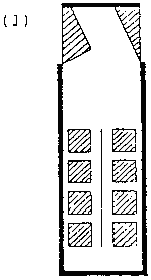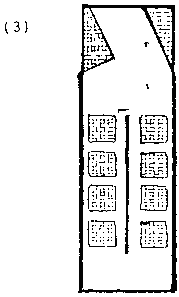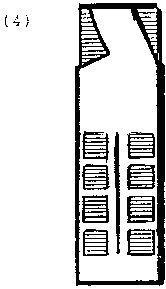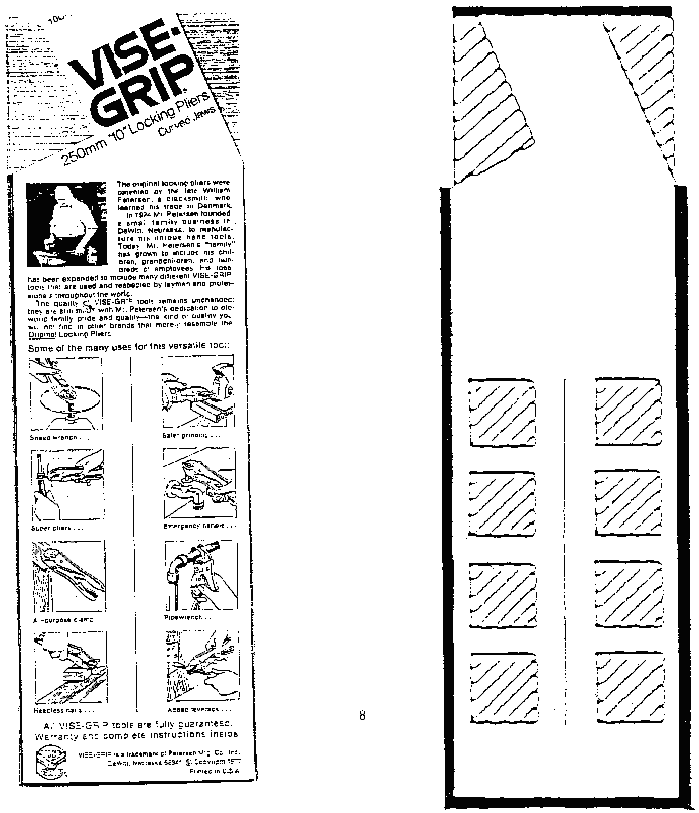Trademark Trial and Appeal Board
Patent and Trademark Office (P.T.O.)
*1 IN RE PETERSEN MANUFACTURING CO., INC.
Serial Nos. 396,753, 398,287, 398,555 & 398,751
February 20, 1987
Hearing: July 17, 1986
James, E. Siegel, Henry A. Marzullo, Jr. and Howard N. Aronson for applicant
Jody H. Drake
Trademark Examining Attorney
Law Office 3
(Myra K. Kurzbard, Managing Attorney), S.N.'s 398,287, 398,555 & 398,751
Abram I. Sachs
Trademark Examining Attorney
Law Office 8
(Sidney Moskowitz, Managing Attorney), S.N. 396,753
Before Rooney, Simms and Cissel
Members
Opinion by Cissel
Member
Applicant applied to register the four designs shown below on the Principal Register for various hand tools.
[FN1]
The designs sought to be registered are described in the respective applications as 'representing the rear panel of a container for the goods' including the various squares and triangular areas which are shown in the respective colors.
In each case applicant was refused registration under Sections 1, 2 and 45 of the Act on the grounds that the subject matter presented for registration is only ornamentation of the container for applicant's goods, and as such, does not function as a trademark to identify the source of applicant's goods.
Applicant responded to the refusals by contending that registration is appropriate under Section 2(f) of the Act, claiming that the designs have acquired distinctiveness. In support of this contention applicant submitted the declarations of its director, Alan D. Petersen. In his declarations Mr. Petersen states, in essence, that the designs were adopted with the intention of distinguishing applicant's goods; that the designs have been in use for over five years; that the goods are promoted and sold using boxes incorporating the designs; that hundreds of thousands of dollars worth of the goods have been sold in containers bearing the design; and that he believes that the design is well known and indicates to the trade and to the public that the goods emanate from applicant. Examples of advertisements and promotional materials were also made of record, but the design sought to be registered was not shown in any of them. It apparently is used only as part of the back of the packages in which applicant's goods are sold. The promotional materials showed the front of the boxes, but not the back.
Also of record are declarations from customers, both in the trade and at retail, who have purchased applicant's tools in packages bearing the designs sought to be registered. The declarants who are retail consumers state the following:
1. Through the years I have purchased different types of tools manufactured by various tool companies, and have purchased tools manufactured by PETERSEN MANUFACTURING CO., Inc. of DeWitt, Nebraska.
2. I recognize that PETERSEN uses designs as trademarks on the backs and fronts of its packaging and containers. I also recognize that these design trademarks are in four colors: BLUE, RED, GREEN and YELLOW.
*2 3. These designs indicate to me that the source of the tools packaged in these containers, and the containers themselves, is (sic) from PETERSEN alone, and therefore act as trademarks and are only incidentally ornamental and decorative.
Submitted as proof that the designs are distinctive in the trade is the declaration of Lowell Larson, Vice President of SNAP-ON TOOLS CORPORATION, a distributor of applicant's tools. The declaration submitted for S.N. 398,287 states, in pertinent part, as follows:
By virtue of the continuous and extensive use which PETERSEN has made of its mark in relation to the goods, my Company recognizes that PETERSEN's mark MISCELLANEOUS DESIGN (BLUE BACK) has become very well known in the United States in relation to the goods and indicates to my Company that such goods emanate from Petersen alone.
The declarations submitted in the other applications refer to applicant's 'mark' as 'MISCELLANEOUS DESIGN (RED BACK),' 'MISCELLANEOUS DESIGN (GREEN BACK),' and 'MISCELLANEOUS DESIGN (YELLOW BACK),' respectively.
The Examining Attorneys [FN5] were not persuaded by applicant's evidence and arguments. When the refusals to register were made final, applicant appealed.
Because the issues are the same, all four cases were consolidated for purposes of the oral hearing. Our decision, based on the reasoning set forth in this opinion, is the same for all four cases.
The issue for our determination is whether the materials presented for registration are trademarks; that is, whether the designs shown in the drawings functions as source identifiers for applicant's products. We hold that they do not, and accordingly affirm the refusals to register.
There can be no dispute that designs can be registered as trademarks, even if they are to an extent ornamental and esthetically pleasing. To be registrable, such a design must identify the goods and distinguish them from similar goods produced or sold by others. Potential purchasers of the goods must see the design as a symbol of origin. Even design portions of labels, without the words that also appear on the labels, have been held registrable where it was established that the design, by itself, was only incidentally ornamental or decorative and served the primary function of identifying and distinguishing the goods. In re Swift & Co., 223 F.2d. 950, 106 USPQ 286, (CCPA 1955).
In order to understand what applicant is trying to register here we need to examine the specimens carefully. Because all four applications are essentially the same, we will take S.N. 396,753 as an example. Below on the left is shown a photocopy of the complete back panel of the box in which applicant's pliers are sold. The design which applicant asserts is its trademark is shown (albeit greatly enlarged from the drawing) on the right.
On the product container back the three-and four-sided shapes at the top of the box are green, as are the eight squares below, which contain drawings of how the tool may be used. Everything in each of these illustrations is green, with the exception of the tool itself, which is shown in white.
*3 Left without any additional evidence to the contrary, we would have no trouble concluding that the design sought to be registered is merely ornamental and does not function as a mark. The two shapes at the top of the box are not particularly distinctive. They appear to act as a pair of margins or borders between which applicant's word mark and descriptive product information are shown. The squares below are simply shaded illustrations of how the pliers can be used. The heading above them emphasizes that they are in the nature of suggestions or instructions. Nothing about any of the green areas or the black border is unusual or otherwise indicative that prospective purchasers would recognize any of it as an indicator of source.
There is, however, additional evidence, in the form of the aforementioned declarations, which applicant contends support its conclusion that the designs have become distinctive of its goods. We cannot conclude from these declarations that these otherwise ordinary decorative parts of applicant's packaging graphics act as trademarks to identify the source of applicant's tools.
Mr. Petersen's declarations talk about extensive use of the designs and claim that they were intended to serve as trademarks, but his conclusion that they actually do so cannot be considered proof of this point. There is no evidence that the back of the tool package has been promoted as a mark. Moreover, the critical question of whether the designs are source identifiers is not resolved solely on intention of applicant or even promotion of the designs as a mark. It is determined by prospective purchasers' recognition of the designs as indicators of the source of the goods.
The declarations from retail customers and from applicant's distributor might have been persuasive on this point, but they are unclear. The declarations from retail customers do not specifically identify what it is that they recognize as applicant's trademarks. All that the declarants say is that they recognize that applicant 'uses designs as trademarks on the backs and fronts of its packaging and containers' and that the marks 'are in four colors: BLUE, RED, GREEN and YELLOW.' Each design sought to be registered is not in four colors. Each is presented in a single color with a black border. Moreover, the indefinite description 'designs' is not specific enough to positively identify what the purported mark is. This term could easily include the top left square containing Mr. Petersen's photograph or the angles created by the slanted writing at the top of the box.
Likewise, Mr. Larson's declaration fails to accurately identify what it is that he recognizes as applicant's marks. 'MISCELLANEOUS DESIGN (BLUE BACK)' is hardly a clear description of the features of the back of applicant's package which are purported to serve as a source identifier.
If the customer declarations had specifically referred to the designs shown in the drawings in the specific applications or had described these designs with specificity, the declarations might have had some persuasive value. As it is, they do not persuade us that the particular designs sought to be registered function as trademarks. Accordingly, in the absence of evidence to the contrary, we must conclude that the designs are merely decorative, ornamental features of the back of the container for applicant's goods, and would be perceived as such, rather than source-identifying trademarks.
*4 Decision: The refusal is affirmed.
L. E. Rooney
R. L. Simms
R. F. Cissel
Members, Trademark Trial and Appeal Board
FN1. S.N. 396,753, filed September 30, 1982 for "locking hand tools, namely, locking pliers having curved jaw." Use since January 6, 1978 was claimed. The drawing is lined for the color green.
FN2. S.N. 398,287, filed September 30, 1982 for "locking hand tools, namely, pinch-off welding clamp and chain clamp pipe wrench." Use since January 6, 1978 was claimed. The drawing is lined for the color blue.
FN3. S.N. 398,555, filed September 30, 1982 for "locking hand tools, namely, locking pliers having curved jaws and wire cutter." Use since January 6, 1978 was claimed. The drawing is lined for the color yellow.
FN4. S.N. 398,751, filed September 30, 1982 for "locking hand tools, namely, locking pliers having straight jaws." Use since January 6, 1978 was claimed. The drawing is lined for the color red.
FN5. Regrettably, and in apparent disregard of Patent and Trademark policy [TMEP § 1102.03(4)], these four applications were examined by two different Examining Attorneys, although the marks and the goods are almost the same in each application.






